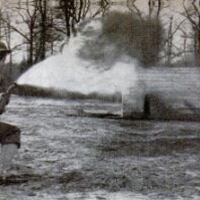Assault Troops Silence Pillboxes with Fire
Item
-
Title (Dublin Core)
-
Assault Troops Silence Pillboxes with Fire
-
Article Title and/or Image Caption (Dublin Core)
-
Assault Troops Silence Pillboxes with Fire
-
extracted text (Extract Text)
-
THE flame thrower or liquid-fire gun is
e most spectacular of all the weapons
of war. German flammenwerfer units
have been credited with great accomplish-
ments during the drive through the Low
Countries and France in 1940. Judging by
the numerous reports of its use, both the
Germans and Japanese consider it has a
very definite place in a carefully organized
attack on a fortified position, and is a use-
ful weapon for clearing dugouts, trenches,
and emplacements.
The range of a flame thrower depends up-
on the distance that the burning oil can be
thrown before it is broken into a fine spray
or consumed by burning. Because of the
short range of the portable device, it is
essential for the man operating it to get
very close to his target to make the flame
effective. A German attack on a concrete
emplacement or pillbox begins with heavy
bombing or artillery fire. Close behind this
bombardment the engineers and infantry
approach with wire cutters, grenades, and
heavy explosives supported by smoke and
strong machine-gun and rifle fire. When a
breach is made in the barriers surrounding
the pillbox, the flame-thrower detachment
rushes close in and directs flame against
the openings and sides of the emplacement.
Where the flame strikes, there is a blazing
mass that flows through every crack and
loophole and burns fiercely on the other side.
Flame throwers were not used by Ameri-
can troops in the First World War. While
they were several times attacked by flam-
menwerfer units, our riflemen and machine
gunners made it difficult for the Germans
to get close enough to do any harm. The
only work done on the flame thrower at
that time by the Chemical Warfare Service
was the carrying on of investigations re-
lating to the possibility of its development.
The German flame
throwers of the First World
War were of two types,
which are similar to those
now employed: a large one to be buried on
the parapet of a trench, with a supposed
range of 60 to 70 yards, and a smaller type
to be carried on a man’s back, with a range
of about 25 yards. Both types consisted of
a receptacle divided into two tanks, the
upper filled with nitrogen under a pressure
of 1,200 to 1,400 pounds per square inch,
the lower filled with inflammable oil. To the
receptacle was fitted a long, flexible tube
with a nozzle containing an automatic fric-
tion lighting device. When valves were
opened, the oil was subjected to pressure of
the nitrogen and forced through the tube.
In the American experiments during the
first World War, the Lawrence projector
made by the British was used, and Ameri-
can flame throwers grew out of this appara-
tus. The Lawrence consisted of an oil res-
ervoir holding three gallons of inflammable
fluid, a container of propellant gas under a
pressure of 1,000 pounds per square inch
located inside the oil reservoir, a nozzle for
directing the stream, and an ignition sys-
tem for igniting the oil as it left the nozzle.
This system consisted of six small cart-
ridges carried in a case similar to that of
an automatic pistol. For firing, they were
pushed into place by means of a rod along
the discharge pipe and were ignited by an
electric current from a small battery. One
lever operated by the left hand controlled
the opening of the propellant-gas container
and fired the cartridge.
All flame throwers follow about the same
pattern: a reservoir of oil, a source of pres-
sure to expel the oil through a pipe, and a
device to ignite the fuel. The principal dif-
ference lies in the ignition devices. Ignition
may be with an electric spark lighting a
stream of easily combustible gas, a car-
tridge to ignite the gas, or a friction lighter
which ignites a fast-burning mixture of
combustibles, all of which in turn supply
the necessary heat to ignite the flame-pro-
ducing liquid.
-
Contributor (Dublin Core)
-
Col. Alden S. Waitt (writer)
-
Language (Dublin Core)
-
eng
-
Date Issued (Dublin Core)
-
1942-08
-
pages (Bibliographic Ontology)
-
38-41
-
Rights (Dublin Core)
-
Public Domain (Google Digitized)
-
Archived by (Dublin Core)
-
Roberto Meneghetti
-
Marco Bortolami (editor)
 Popular Science Monthly, v. 141, n. 2, 1942
Popular Science Monthly, v. 141, n. 2, 1942
 Cattura.JPG
Cattura.JPG
